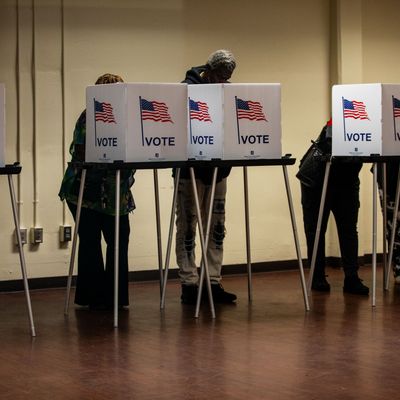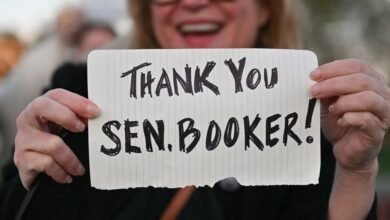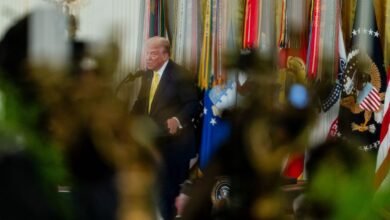2024 Election Could Hinge on Tiny Shifts in the Electorate


Photo: Emily Elconin/Bloomberg via Getty Images
It’s always possible the polls are all wrong and either Donald Trump or Kamala Harris is on the brink of a decisive victory on November 5. For one thing, it’s close enough in the seven battleground states that either candidate could win all of them. But make no mistake: This apparently very close presidential election reflects a deeply divided electorate where the potential changes in either direction we all talk about constantly are glacial and arguably self-canceling. Ron Brownstein points out how very small demographic changes since 2020 might wind up being a big deal:
Extending a pattern that stretches back decades, White voters without a college degree, the cornerstone of the modern GOP coalition, have declined by a little more than 2 percentage points as a share of eligible voters since 2020, falling below 40% of the eligible voting pool for the first time ever, according a new analysis of the latest Census Bureau data by demographer William Frey shared exclusively with CNN.
While those working-class Whites are shrinking, Frey found that both Whites with at least a four-year college degree and voters of color have each increased since 2020 by about a single percentage point as a share of eligible voters. Those increases also continue long-term trends that have seen well-educated Whites grow to represent more than 1-in-4 eligible voters and people of color rise past 1-in-3.
A vote’s a vote, but these small shifts help explain why Kamala Harris is focused on consolidating and extending recent Democratic gains among white college-educated voters — particularly women who support reproductive rights — while Donald Trump is working hard to expand his own party’s beachheads among non-college-educated Black and Latino voters, particularly the men open to his highly gendered, machismo message.
Demographic change varies, of course, across individual states, and that could matter on Election Day as well, notes Brownstein:
[I]n a race so close, small shifts in the electorate’s composition across the most competitive states could make a difference. For instance, the fact that non-college Whites, according to Frey’s analysis, have fallen as a share of the eligible electorate since 2020 considerably more in Michigan and Wisconsin than in Pennsylvania may help explain why most analysts consider the Keystone State more difficult than the other two for Harris …Across the Sunbelt battlegrounds, blue-collar Whites are a smaller share of the eligible voters: about 1-in-3 in Arizona, Georgia and Nevada and just over 2-in-5 in North Carolina. Arizona and Georgia saw big increases since 2020 in the minority share of their eligible voter population, Frey found, while non-Whites actually declined somewhat in North Carolina and remained almost unchanged in Nevada. College-educated Whites increased as a portion of eligible voters in Nevada and Arizona, while falling slightly in Georgia and essentially holding steady in North Carolina.
It’s as though all these trends are conspiring to produce the closest election since 2000. Yet thanks to our winner-take-all electoral machinery, we will not have the sort of coalition government a different kind of political system would probably mandate in such circumstances. Instead, we’ll have a Harris or Trump administration with a strongly partisan character (and in the case of a Trump administration, a notably radical character) and a strong interest in aggressive use of executive powers. If Trump wins, the odds are better than even he will also be part of a governing trifecta that could very well run roughshod over Democrats and independents thanks to such power-enhancing measures as filibusterproof budget-reconciliation bills, abetted by a conservative-leaning federal judiciary. And that will be true even though it is quite likely that whatever happens in the Electoral College, Trump will be on the losing end of the national popular vote (Nate Silver currently gives Trump a 53 percent probability of winning the presidency but only a 27 percent probability of winning the popular vote).
Very big differences in the direction of the country will flow from tiny shifts in one direction or another of a closely divided electorate. It’s why anxiety levels are so high right now among those paying avid attention to politics, even though the outcome may depend on “low-propensity voters” barely paying attention at all.
Source link





